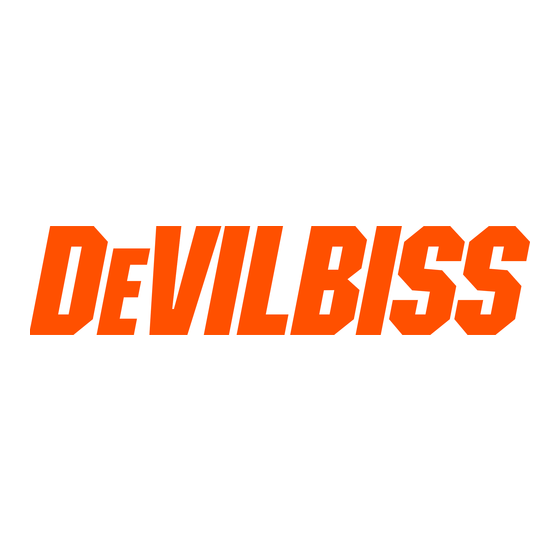
Advertisement
Quick Links
DEVILBISS
SERVICE BULLETIN
SB-2-240-C
Replaces SB-2-240-B
AUTOMOnYE REFINISHING PIIODUCiS
Repair Kil KK-4987-1
JGHV-530 High Volume
Low Pressure Spray Gun
IMPORTANT: Before using this equipment, read all
safety precautions and Instructions. Retain lor fu-
ture use.
DESCRIPTION
The JGHV-530 is a primary, auto refinish HVLP spray
gun designed to apply a wide variety of finishing materi-
als. This gun was manufactured to comply with SCAQMD
and other air quality authorities by limiting the air cap
pressure to 10 psi. This spray gun is intended for use
with pressure feed paint supply only.
The No. 33 air cap and gun is intended for small or partial
jobs. The No. 57 air cap and gun is intended for larger
jobs, completes and fleet refinishing jobs. Refer to the
Air Cap Chart 2 lor more information.
INSTALLATION
Connect the gun to a clean, moisture and oil tree air
supply using a hose size of at least 5/16" I.D . Depending
on hose length, larger I. D. may be required. Install an air
adjusting valve/air gauge, HAV-501, at the gun handle
and air cap test kit,see "Accessories",
over
tip. For
maximum gun pertonmance and to assure code
compliance, set the air cap presssure at10 pslg or
less. Remove the air cap test kit and install the air cap.
OPERATION
Adjust fluid pressure to deliver the desired paint volume.
As a general rule of thumb, the following fluid flow and tip
sizes should be followed.
Tip
Cap
Size
Flow (oz /min.)
DFX
57
.042
10-14
FX
33
.042"
10
GX
33
.034'
6
Excessive flow rates will resutt in heavy center spray
patterns. Inadequate flows may cause the pattern to
split.
See Spray Gun Guide, SB-2-001, for details
concerning set up of spray guns.
HVLP requires gun distances of 6-8" be used. Excess
distance will produce inferior results.
Strain material thru 60 or 90 mesh screen.
Best atomization will occur with 10 psig air cap pressure.
However, some materials can be sprayed at lower pres-
sures which will result in higher transfer efficiency.
PREVENTIVE MAINTENANCE
To clean fluid passages, remove excess material at
source, then flush with a suitable solvent.
To clean air cap and fluid tip, brush exterior wtth a stiff
bristle brush. If necessary to clean cap holes, use a
broom straw or toothpick. Never use a wire or hard
Instrument. This may scratch or burr holes causing a
distorted spray pattern.
Wipe gun exterior with a solvent dampened cloth. Never
completely immerse in solvent as this is detrimental to
the performance and gun life expectancy, as well as
destroying the lubricants and packings.
Note
When baffle (6) & fluid tip (3) are removed, seal (4) and
0-Ring (27) should be replaced. For your convenience,
an extra seal & 0-Ring is included wtth this gun. Be sure
to lubricate the ID of the baffle and 0-Ring with SSL-10
gun lube to prevent 0-Ring damage during installation.
Spray Gun Lubrication
Daily, apply a drop of gun lube at trigger bearing stud (19)
and the stem of the air valve (14) where it enters the a1r
valve assembly (17). The shank of the fluid needle (29)
where it enters the packing nut (23) should also be oiled.
The fluid needle packing (22) should be kept soft and
pliable by periodic lubrication. Make sure baffle and
retaining ring threads are clean and tree of foreign
matter. Before assembling air cap to baffle, add one
drop of gun lube to threads.
The fluid needle spring (31) should be coated with a light
grease. The air valve spring (15) should be coated with
a very light grease, ensuring that any excess grease will
not clog the air passages. For best results, lubricate the
points indicated, daily.
A. Trigger points
B. Packing
C. Adjusting valve
D
D. Baffle & retaining ring threads
E. Air valve cartridge
©Copyright 1994, DeVilbiss Automotive Refinishing Products
Advertisement











Need help?
Do you have a question about the JGHV-530 and is the answer not in the manual?
Questions and answers